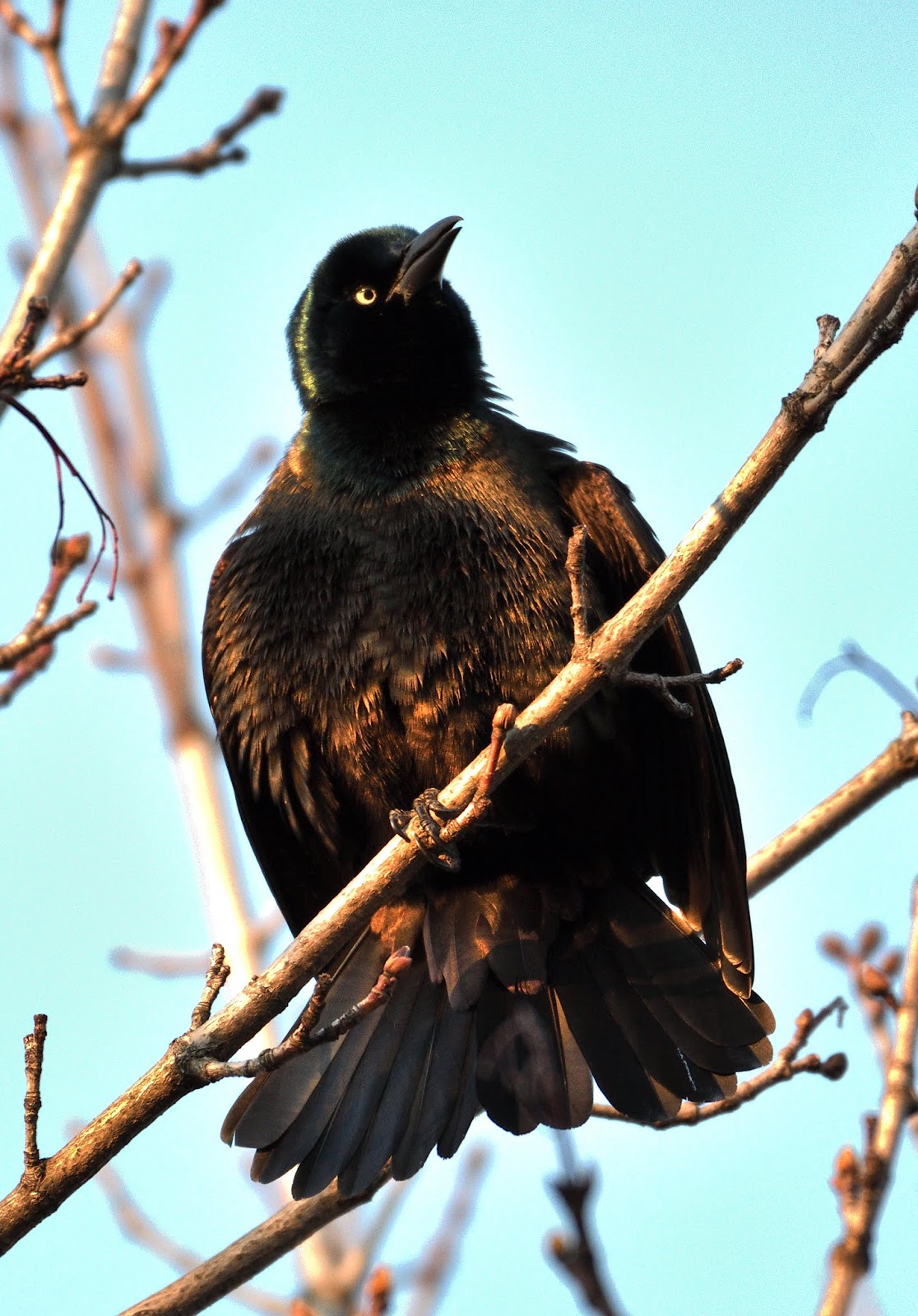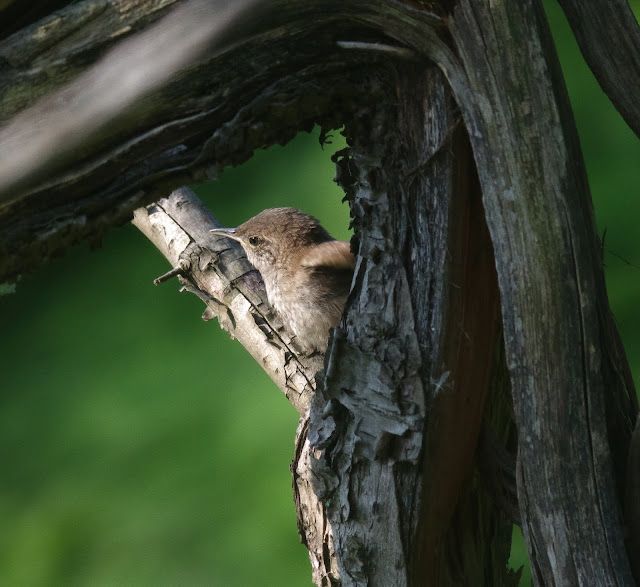Reflecting Light
I did mention in my previous post that I observed a common grackle at Lakeside Park, although I was unable at the time to obtain photos of any worth. One day later though, as I walked back from the Borden Wetlands and through Highbrook Park, I came across lots of grackles. They appeared to be singing to the sun which had barely ten minutes left before it dipped below the horizon.
When the sun is this low, it paints everything with a glorious warmth. The grackles kept to the highest branches, eager to stay in the sun's golden hue.
The low sunlight, combined with the iridescent qualities of the grackles feathers, painted the grackles in gold. Here is a male displaying to the world with a familiar pose:
I'd normally expect to see a male red-winged blackbird displaying in that fashion with its epaulettes blazing.
These photos were taken at Lakeside Park, the morning after the grackle photos. The grackle and red-winged blackbird are shown displaying similarly and both also reflect light in different colours with their feathers. Not surprisingly, both are of the same family, Icteridae. They are New World passerine birds and they are not alone in their ability to split light into different colours.
An introduced bird from the Old World also displays that same ability. This common starling was showing just how exotic it can appear. Pictured as it checked out a suitable nesting location at the bottom edge of the lake.
Two days later in some really blustery weather, and even though it was overcast and dark, I took a couple of photos that represent perfectly what I described above. With the light reflecting off the feathers on the male mallard's neck in one direction, the feathers appear to be bright blue.
Same mallard in this photo, but with the light now reflecting off the feathers in the opposite direction, the mallard's neck feathers appear to be bright green.
As you can see, the warmer weather is gradually thawing the frozen lake, particularly where the water is moving faster, and the ducks and geese are really enjoying getting their feet wet again. I took the following photo in low light, and in the same location as the mallards. The photo is showing grain, but I do like how the picture displays what appears to be teeth in the goose's mouth. The tooth-like structures are actually made of cartilage and help the goose pull up vegetation from the ground or aquatic plants from the bottom of the lake.
The majority of the lake is still frozen though, which makes it even more surprising this morning to hear and then momentarily see a kingfisher flying over the lake. I circled the lake in the hope of seeing the kingfisher again, but I could not locate it. I had unfortunately missed my chance of a photo.
The subject of the following picture is not quite as colourful as a kingfisher, but looking just as elegant with the wind blowing its head-crest up, is an American tree sparrow.
On to Saturday morning, and another overcast day with not a great deal of light. It was a cold damp day, with the temperature just hovering on freezing. I did, however, manage to capture a bird that had somehow managed to elude me all winter. A tiny bird that I always enjoy seeing, a house wren.
Something else that had so far eluded my camera, was the American crows, feeding on the large seedheads of bushes spotted around the lake.
I had observed American crows feeding on these seedheads before, but I had no idea what the bushes were.
A little digging soon pulled up what I believe is, staghorn sumac. A native deciduous shrub, named "staghorn" as its hairy branches resemble the velvety antlers of a male deer (stag). The photos were taken under really dark conditions, but even in this light, the American crow's feathers still show off their own velvety blue iridescent sheen.
One day later and we were finally graced with Ontario's rich blue sky. With the snow now almost gone, I observed this American Robin foraging on the ground, and apparently, they also like to eat the staghorn sumac berries.
I heard a red-bellied woodpecker after taking this photo. The calls came from the far side of the lake, and I duly gave chase.
I found two red-bellied woodpeckers. One was busily chipping out a hole, halfway up a dead tree.
I decided to work my way to the top of the lake from here through the undergrowth and not on the well-worn paths. I'd already had two close encounters with a German Shepherd running loose and did not want a third. I was soon cursing my luck though, not because of a dog off its leash, but because I completely missed the opportunity that flew up right in front of me; a woodcock that I did not see at all! I came out of the undergrowth at the top edge of the lake and saw another bird chipping away at a dead tree trunk.
A chickadee pecked away in woodpecker fashion until it had a hole as big as its head.
And somewhere in the beakful of wood chippings, this chickadee had its prize which it flew off with to eat in safety.
One final photo, that is proof that spring is here. A male goldfinch with its summer plumage starting to show through.
Copyright © wildlakeside.blogspot.com 2020 Scott Atkinson All Rights Reserved.
When the sun is this low, it paints everything with a glorious warmth. The grackles kept to the highest branches, eager to stay in the sun's golden hue.
The low sunlight, combined with the iridescent qualities of the grackles feathers, painted the grackles in gold. Here is a male displaying to the world with a familiar pose:
I'd normally expect to see a male red-winged blackbird displaying in that fashion with its epaulettes blazing.
These photos were taken at Lakeside Park, the morning after the grackle photos. The grackle and red-winged blackbird are shown displaying similarly and both also reflect light in different colours with their feathers. Not surprisingly, both are of the same family, Icteridae. They are New World passerine birds and they are not alone in their ability to split light into different colours.
Same mallard in this photo, but with the light now reflecting off the feathers in the opposite direction, the mallard's neck feathers appear to be bright green.
As you can see, the warmer weather is gradually thawing the frozen lake, particularly where the water is moving faster, and the ducks and geese are really enjoying getting their feet wet again. I took the following photo in low light, and in the same location as the mallards. The photo is showing grain, but I do like how the picture displays what appears to be teeth in the goose's mouth. The tooth-like structures are actually made of cartilage and help the goose pull up vegetation from the ground or aquatic plants from the bottom of the lake.
The majority of the lake is still frozen though, which makes it even more surprising this morning to hear and then momentarily see a kingfisher flying over the lake. I circled the lake in the hope of seeing the kingfisher again, but I could not locate it. I had unfortunately missed my chance of a photo.
The subject of the following picture is not quite as colourful as a kingfisher, but looking just as elegant with the wind blowing its head-crest up, is an American tree sparrow.
On to Saturday morning, and another overcast day with not a great deal of light. It was a cold damp day, with the temperature just hovering on freezing. I did, however, manage to capture a bird that had somehow managed to elude me all winter. A tiny bird that I always enjoy seeing, a house wren.
Something else that had so far eluded my camera, was the American crows, feeding on the large seedheads of bushes spotted around the lake.
I had observed American crows feeding on these seedheads before, but I had no idea what the bushes were.
A little digging soon pulled up what I believe is, staghorn sumac. A native deciduous shrub, named "staghorn" as its hairy branches resemble the velvety antlers of a male deer (stag). The photos were taken under really dark conditions, but even in this light, the American crow's feathers still show off their own velvety blue iridescent sheen.
One day later and we were finally graced with Ontario's rich blue sky. With the snow now almost gone, I observed this American Robin foraging on the ground, and apparently, they also like to eat the staghorn sumac berries.
I heard a red-bellied woodpecker after taking this photo. The calls came from the far side of the lake, and I duly gave chase.
I found two red-bellied woodpeckers. One was busily chipping out a hole, halfway up a dead tree.
I decided to work my way to the top of the lake from here through the undergrowth and not on the well-worn paths. I'd already had two close encounters with a German Shepherd running loose and did not want a third. I was soon cursing my luck though, not because of a dog off its leash, but because I completely missed the opportunity that flew up right in front of me; a woodcock that I did not see at all! I came out of the undergrowth at the top edge of the lake and saw another bird chipping away at a dead tree trunk.
A chickadee pecked away in woodpecker fashion until it had a hole as big as its head.
And somewhere in the beakful of wood chippings, this chickadee had its prize which it flew off with to eat in safety.
One final photo, that is proof that spring is here. A male goldfinch with its summer plumage starting to show through.
Copyright © wildlakeside.blogspot.com 2020 Scott Atkinson All Rights Reserved.
























Comments
Post a Comment